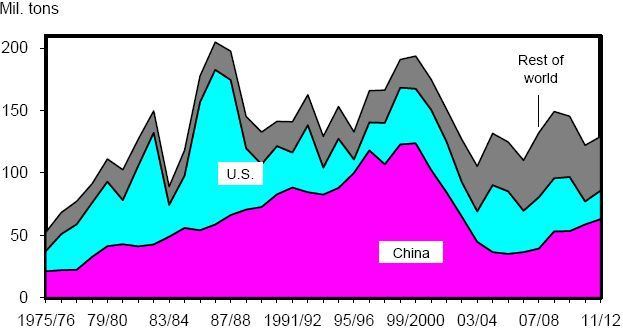Reduced Coarse Grains Beginning Stocks Tighten Supplies in 2011/12
Global coarse grain beginning stocks for 2011/12 are forecast at 158.4 million tons, down 20 percent from a year earlier. This reflects global use exceeding production in 2010/11. The reduction in beginning stocks of 38.4 million tons offsets much of the 2011/12 increase in production of 62.2 million, leaving supplies increasing only modestly. Much of the decline in 2011/12 beginning stocks is in the United States, but foreign stocks are down 12.6 million tons to 136.0 million. The largest foreign holder of coarse grain stocks, China, is forecast to start 2011/12 with stocks up 5.2 million tons to 59.6 million.
However, the Government of China regards grain stocks as a state secret, and it is not clear what coarse grain stocks are actually available to the market in China. In contrast, EU coarse grain stocks are estimated to begin 2011/12 down 10.6 million tons to 15.2 million as the EU Commission takes advantage of high market prices to liquidate intervention stocks. Canada’s stocks are forecast down 2.2 million tons to only 3.5 million. Droughtreduced production in 2010/11 cut FSU 2010/11 beginning stocks 2.6 million tons to 4.5 million. Strong domestic use and exports trimmed Brazil’s forecast beginning stocks 1.3 million tons to 9.0 million.
Global ending corn stocks

South Africa is expected to trim burdensome stocks 0.6 million tons to 4.7 million. Venezuela, Turkey, and Saudi Arabia are forecast to reduce coarse grain beginning stocks 0.5 million tons each. Australia is expected to cut stocks 0.4 million tons year-to-year. Countries with an increase in coarse grain beginning stocks include Argentina, up 0.9 million tons to 1.9 million; Sudan, up 0.5 million to 0.8 million; and India and Ethiopia, up 0.4 million each.
Source: USDA